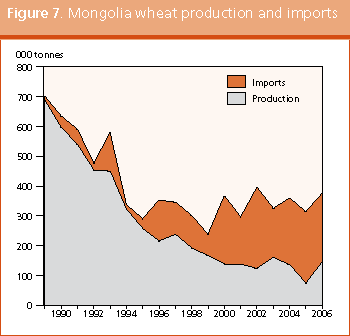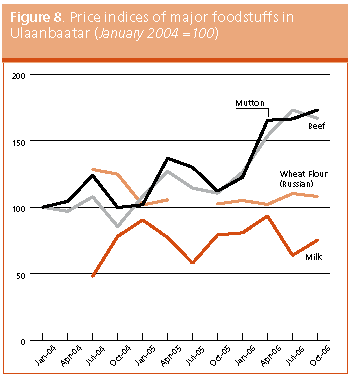No.4  November 2006 November 2006 | ||
 |
Crop Prospects and Food Situation | |
|
Special features
At the request of the Ministry of Food and Agriculture of Mongolia, a UN Joint Mission comprising FAO, UNICEF and UNDP visited the country from 2 to 20 October 2006 to undertake a rapid assessment of the food security situation. The overall economic context for food security is favourable, with the
economy growing at a steady rate since 2004 and mining exports soaring
supported by record prices of minerals.
Flour, meat and milk products are the main food staples of Mongolia. According
to estimations made in the framework of the “Household Income and Expenditure
Survey/Living Standards Measurement Survey 2002/03”, these three products
cover some 86 percent of the average daily caloric intake. Although consumption
of animal products is among the highest in the world, cereals are the
main source of energy providing some 55 percent of the daily intake. Despite
rapid increases in consumption of potatoes, vegetables and fruits in recent
years, particularly in urban areas, the diet of Mongolians remains deficient
in these products.
Wheat is the main crop in Mongolia. Production has declined steadily since
1990 following the break-up of the Soviet Union and the subsequent loss
of massive government subsidies. As a result, commercial imports and food
aid of wheat and wheat flour have increased (Figure 7). As a result of severe drought during the 2005 cropping season, Mongolia gathered
only 74 000 tonnes of wheat, the lowest crop on record, and imported an
estimated 251 000 tonnes in 2005/06 marketing year (October/September).
Production recovered this year 
The livestock sector suffered successive harsh winters (Dzud in local language)
and summer droughts from 1999-2002 which caused the loss of about 10 million
camels, horses, cattle, sheep and goats, or some 30 percent of the total
livestock numbers, prompting migration to the cities of large section
of the rural population. The sector has recovered since 2004 and preliminary
estimates point to numbers of animals in 2006 similar to the 1999 record
levels. This is the result of successive years of favourable weather conditions,
investments in response to improved returns for animal products as well
as low animal take-off. The country is self-sufficient in meat and has an exportable surplus. Following
the sharp decline from 2001 to 2003, production of meat has recovered
in the past two years, but by 2005 still remained 38 percent below the
level of 2000 and exports are very limited. Mongolia used to be self-sufficient in milk in the socialist period. Similar to the rest of the food sector, the dairy industry collapsed during the abrupt transition from State to private ownership in the early 1990s. The decline of the national herd in 2000-2002 resulted in the plummeting of the milk production and the import of almost all the milk and milk products sold in urban markets. Total milk production has been recovering markedly since then and by 2005 production of milk was only 10 percent lower than in 2000. While most of the processed milk is still imported, due to the limited connection between producers and urban consumers, the formal milk and dairy sub-sector is also reviving and the component of domestic produced milk in the milk industry has increased from some 3 percent in 2003 to about 7 percent in 2005. Table 12. Mongolia: livestock numbers, output and trade
|
||||||||||||||||||||||||||||||||||||||||||||||||||||||||||||||||||||||||||||||||||||||||||||||||||||||||||||||||||||||||||||||||||||||||||||||||||||||||||||||||||||||||||||||||||||||||||||||||||||||||||||||||||||||||||||||||||||||||
1980 | 1990 | 1999 | 2000 | 2001 | 2002 | 2003 | 2004 | 2005 | |
Livestock numbers ( 000 head ) | |||||||||
Camel | 592 | 537 | 356 | 323 | 285 | 253 | 257 | 257 | 264 |
Horses | 1 985 | 2 262 | 3 163 | 2 661 | 2 192 | 1 989 | 1 969 | 2 005 | 2 029 |
Cattle | 2 397 | 2 849 | 3 825 | 3 098 | 2 070 | 1 884 | 1 793 | 1 841 | 1 964 |
Sheep | 14 231 | 15 083 | 15 191 | 13 876 | 11 937 | 10 637 | 10 756 | 11 687 | 12 885 |
Goat | 4 567 | 5 126 | 11 034 | 10 270 | 9 591 | 9 135 | 10 653 | 12 238 | 13 267 |
Total | 23 771 | 25 857 | 33 569 | 30 227 | 26 075 | 23 898 | 25 428 | 28 028 | 30 399 |
Total in bod* equivalent ( 000 head ) | 8 208 | 9 067 | 11 430 | 9 837 | 7 876 | 7 165 | 7 270 | 7 707 | 8 193 |
Livestock output ( 000 tonnes slaughter weight ) | |||||||||
Total Meat | 234 | 249 | 289 | 311 | 226 | 204 | 153 | 199 | 193 |
Beef | 71 | 66 | 105 | 113 | 67 | 61 | 44 | 52 | 49 |
Mutton and goat | 116 | 132 | 129 | 120 | 105 | 95 | 81 | 98 | 95 |
Milk | 226 | 316 | 467 | 376 | 290 | 277 | 292 | 329 | 335 |
Eggs ( million units) | 21 | 38 | 10 | 7 | 8 | 4 | 7 | 16 | 21 |
Trade of main livestock products | |||||||||
Milk Powder imports ( tonnes) | na | 1 038 | 365 | 346 | 1 385 | 835 | na | na | na |
Meat exports ( 000 tonnes) | na | 24 | 15 | 17 | 20 | 23 | 15 | 8 | 8 |
Intestine exporte ( 000 rolls) | na | 2 164 | 1 025 | 870 | 368 | 316 | 223 | 278 | 295 |
Edible meat offal Export ( tonnes) | na | na | 3 151 | 812 | 3 430 | 1 629 | 887 | 6 | 404 |
Availability of foodstuffs in the markets is good and prices are stable (except for meat) |
 |
Markets in Mongolia have a particular importance for access to food since the majority of the population lives in urban areas (some 60 percent) and are buyers of food. In rural areas, herders are self-sufficient in meat and dairy products but need to acquire all other food products, in particular flour, an important component in their diets. Trade liberalization has contributed to improve availability and stability of food supplies. Markets throughout the country are well-stocked with food products, including wheat flour, rice, vegetables and fruits. Prices of most basic foods, except meat, have remained stable or have declined since 2000 in real terms. While the decline in prices of basic food has overall favoured access to food, the largest reductions have been in prices of flour products and vegetables, which are the main staples of the low-income groups of population. The improvement of the terms of trade between meat/flour and meat/potatoes has also benefit herder populations’ access to food.
Meat prices in domestic markets are well below those in the world market, highlighting the country’s export potential, but also the difficulties to import in time of crisis. Meat prices have been increasing significantly in the past three years reflecting the reduced meat supply. As a result of the long and cold Mongolia winter, there is marked price seasonality with prices of meat and vegetables increasing in spring months, and those of milk rising in winter (Figure 8).

Satisfactory food consumption at national level |
 |
At national level, the food security situation is satisfactory. Average per capita annual consumption of basic foods has augmented since 2000.2 Rates of meat and dairy products intakes at 100 kg/pc/year and 140 kg/pc/year in 2005 are high by regional standards, while that of wheat stands at 119 kg/pc/year. Nutritional indicators have also shown general positive trends, with declines in child malnutrition rates in recent years, although micro-nutrient deficiencies persist.
Poor people living in cities are the most food insecure |
 |
However, the bright panorama at national level hides the vulnerability
and food insecurity of large numbers of population. The most food insecure
people are the poor in the cities: Ulaanbaatar and the provincial and
district capitals. These populations have basically no animals (or have
very limited numbers) and their livelihood depends on cash incomes.
The main cause of their food insecurity is insufficient purchasing power
to buy food.
The poor households are mostly people who lost animals and migrate to
cities, where rates
of unemployment and underemployment are very high. Lack of education and
skills of migrants from the countryside make it difficult for them to
find a job in the new environment.
The poor households derive their living from temporary jobs and provision
of services, social benefits, and gifts from wealthier families.
Seasonal labour patterns prevail and during colder months, little to no
working opportunities are available. In this period, the pressure on families’
financial resources is also augmented by the rising living costs as heating
is needed as much as food during the winter.
The poorest strata of the cities’ population cannot afford
to consume meat or milk and their diets are based on flour products, potatoes
and vegetables. Moreover, their access to food is unstable as coping mechanisms
of poor in the cities include skipping on meals during the day or having
them once every two days.
Small
Herders and farmers are generally food secure
|
 |
Herder population, accounting for two-thirds of the rural population
and some 28 percent of the national total, appears to have an adequate
food security situation. In general, this population has a sufficient
intake of food, which includes wheat, meat and milk. Nevertheless, herders
show micro-nutrient deficiencies because of poor diet diversification.
The farmer population is concentrated in Central provinces where they
mainly cultivate wheat and vegetables on commercial basis. Their food
security situation is also satisfactory.
At the same time, however, the high risk of extreme weather changes, mainly
dzuds and droughts, coupled with the lack of livelihood diversification,
make herders and farmers the most vulnerable group of the population.
Large sections of these populations can become destitute and food insecure
from one season to the next if livestock is lost. This is particularly
the case for poor households (commonly defined as those having 25 or less
heads), which represent about one-quarter of the total herder population.
Poor herders are also subject to temporary food insecurity in early spring
when winter stocks of meat and milk products are exhausted and pastures
have not yet regenerated.
While the vulnerabilities and risk of rural and urban populations are different,
there is a continuum between vulnerability in agricultural areas and food
insecurity in the cities.
The urban food insecure people are often vulnerable herders who lost their
animals and migrated to city areas in search of a job but remained unemployed.
1. The purpose of the bod scale is to calculate the size of the herd by transforming all animals into equivalent horses. One horse is assumed to be the same as one cattle (cow or yak), 0.67 camels, six sheep or eight goats.
2. National Statistic Office: “Mongolian Statistical Yearbook”, 2000 to 2005
| GIEWS | global information and early warning system on food and agriculture |